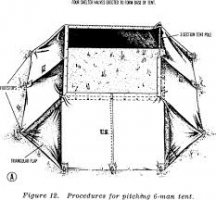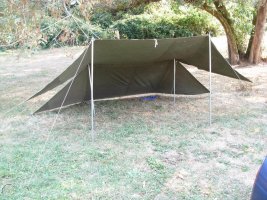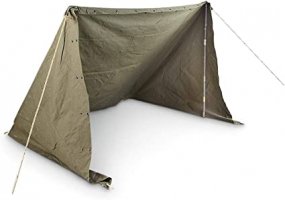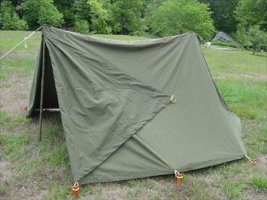Military ground sheet/half shelter tent configurations
- Thread starter Coastal73
- Start date
You are using an out of date browser. It may not display this or other websites correctly.
You should upgrade or use an alternative browser.
You should upgrade or use an alternative browser.
Le Loup
Settler
Got some half shelter/heavy ground sheets with a couple swiss tent pole sets. Looking for info on making some different shelter designs. Thank you.
Hello there. They are Canadian forces surplus 9’ by 5’ grommets, zippers as well I believe from reviews. Heavily made nylon material. I also picked up a German BK rain poncho half shelter rubberized nylon. Thank you.
Hello there. Thank you for the replies. I appreciate all the photos and questions. Looking forward to checking these out and seeing what can work best for me and what I need them for.
The German poncho you can use the best like this:
First you tie with the fisherman's knot cordage loops in all grommet, at home. Large enough for wooden tent stakes, but not too large. Let's say the loops have 5 cm diameter.
The tent stakes never go through the grommets, always through the cordage loops.
You attach to a 150 cm cord two smaller lightweight carabiner hooks in the ends.
One goes into a corner of the poncho, one goes around a tree approximately chest or head high, and clicks into the own rope. You pick up the diagonal opposite corner, tension the poncho to the ground and put in there the first tent stake. Afterwards you peg out the both other corners.
Ready is your plough point shelter!
With a bit practice that's done within one or two minutes.
You can tie out the cord of the hood to a branch or whatever to get more space.
There is a press button that you can use to close the neck hole. The hood should point downwards of course. Or you just pull the draw string tight and wrap it around the hood.
This shelter works the best in combination with a bivvy bag.
I carry only 3 very light aluminium tent stakes like this here for hard ground.
If they aren't thick or long enough I can carve others in place, but that isn't needed in most cases, because the sail surface isn't so large.
These little pegs you just press into the ground by hand in most cases.
 www.decathlon.co.uk
www.decathlon.co.uk
There are a lot of other makers with very similar products.
If you don't use a bivvy bag, you can use the poncho as ground sheet or as bivvy bag too and use another sheet as shelter.
If you aren't too tall the German army poncho serves well as lean to shelter as well.
Your Canadian equipment I don't know. Standard configurations are always possible, but if there are special options I can't tell you.
Do you have a link to the seller?
First you tie with the fisherman's knot cordage loops in all grommet, at home. Large enough for wooden tent stakes, but not too large. Let's say the loops have 5 cm diameter.
The tent stakes never go through the grommets, always through the cordage loops.
You attach to a 150 cm cord two smaller lightweight carabiner hooks in the ends.
One goes into a corner of the poncho, one goes around a tree approximately chest or head high, and clicks into the own rope. You pick up the diagonal opposite corner, tension the poncho to the ground and put in there the first tent stake. Afterwards you peg out the both other corners.
Ready is your plough point shelter!
With a bit practice that's done within one or two minutes.
You can tie out the cord of the hood to a branch or whatever to get more space.
There is a press button that you can use to close the neck hole. The hood should point downwards of course. Or you just pull the draw string tight and wrap it around the hood.
This shelter works the best in combination with a bivvy bag.
I carry only 3 very light aluminium tent stakes like this here for hard ground.
If they aren't thick or long enough I can carve others in place, but that isn't needed in most cases, because the sail surface isn't so large.
These little pegs you just press into the ground by hand in most cases.
Ultralight Non-Anodised Aluminium Tent Pegs MT900 - 10 g (x5) FORCLAZ | Decathlon
Tough and lightweight, these tent pegs are perfect for securing your tent on hard or medium ground. Made with ultralight materials, they're the…
There are a lot of other makers with very similar products.
If you don't use a bivvy bag, you can use the poncho as ground sheet or as bivvy bag too and use another sheet as shelter.
If you aren't too tall the German army poncho serves well as lean to shelter as well.
Your Canadian equipment I don't know. Standard configurations are always possible, but if there are special options I can't tell you.
Do you have a link to the seller?
Last edited:
Yes the dimensions are about 275x150 cms.
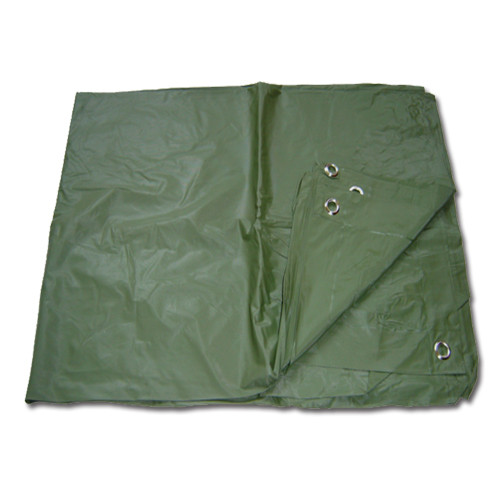
 www.herooutdoors.com
www.herooutdoors.com

Canadian Armed Forces Ground Sheet/Half Shelter
Hero Outdoors is your one-stop army surplus online store in Canada. We offer one of the largest selections of military surplus products, gear and equipment.
150 cm is a bit narrow for my taste.
I would use the Canadian tarp as a lean to shelter and sleep on half the German poncho.
If you awake because it starts to rain you put the other half of the poncho over you.
That isn't the best setup in the world but should work well.
If you have a friend with you, you can do it approximately like in the video. Make sure that the wind goes through the camp from your heads to your feed.
If it's very windy you can set the both tarps in a 90 degrees angle to protect yourself.
I would use the Canadian tarp as a lean to shelter and sleep on half the German poncho.
If you awake because it starts to rain you put the other half of the poncho over you.
That isn't the best setup in the world but should work well.
If you have a friend with you, you can do it approximately like in the video. Make sure that the wind goes through the camp from your heads to your feed.
If it's very windy you can set the both tarps in a 90 degrees angle to protect yourself.
Last edited:
Hello there. I have picked up 4 of these. Also got two sets of the Swiss tent pole sets. Have a BK German rubberized poncho coming as well. Look for ideas on using multiple shelter halves to make a larger shelter for 3-4 people. Anyone have experience with the Canadian Forces 4 Man Crew Tent also known as the Recce tent? Interested in the poles needed to properly set that up.
 www.herooutdoors.com
www.herooutdoors.com
Search - searchresults - Hero Outdoors
You surely mean BW, Bundeswehr, isn't it?
That's the poncho shown in the video above.
4 tent sheets I would set up like post No6 image 1. That creates a heated room around a small fire.
That crew tent seems too heavy to carry in the rucksack.
That's the poncho shown in the video above.
4 tent sheets I would set up like post No6 image 1. That creates a heated room around a small fire.
That crew tent seems too heavy to carry in the rucksack.
Most likely be based on land but travelling by boat as well while on the Coastal areas. Back packing some of the time. Have a light weight 5 person dome tent but interested in other shelter styles like the Tipi style or Laavu or the like. Yes BK
https://www.varusteleka.com/en/product/bw-rain-poncho-rubberized-surplus/1158. Got the Dutch Woobie liner as well.
https://www.varusteleka.com/en/product/bw-rain-poncho-rubberized-surplus/1158. Got the Dutch Woobie liner as well.
See post No 16 in this thread:
 bushcraftuk.com
bushcraftuk.com
In your situation I would go for sure with a Jurtenland / Tortuga Wanderkohte if I can find the poles and tent stakes in the forest. I would carry a Fiskars X7 and a folding frame saw (perhaps Agawa Canyon) to make them and to section the firewood to the needed relatively small size.
In car or boat I would think about additional bought or home made poles.
I use shorter ones than in the video and set them next to the fire stone circle. That's better than the version in the video.
That's a 4 to 8 persons tent. 4 fits very comfortably, 8 is OK.
Additional as ground sheets I would give each a German army poncho or a 350g Italian army poncho made by Defcon 5, available new.
Wax canvas tarps.
Evening all, Would like to ask a bit of advise. I've been using a regular silnylon tarp for a few years now, but soon as pandemic permits. I fancy going the more traditional route. Browse bag, wool blankets and a canvas tarp. Any of you done this old school camp, and could you recommend a...
In your situation I would go for sure with a Jurtenland / Tortuga Wanderkohte if I can find the poles and tent stakes in the forest. I would carry a Fiskars X7 and a folding frame saw (perhaps Agawa Canyon) to make them and to section the firewood to the needed relatively small size.
In car or boat I would think about additional bought or home made poles.
I use shorter ones than in the video and set them next to the fire stone circle. That's better than the version in the video.
That's a 4 to 8 persons tent. 4 fits very comfortably, 8 is OK.
Additional as ground sheets I would give each a German army poncho or a 350g Italian army poncho made by Defcon 5, available new.
Similar threads
- Replies
- 10
- Views
- 915
- Replies
- 31
- Views
- 2K
- Replies
- 28
- Views
- 2K

